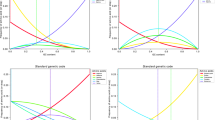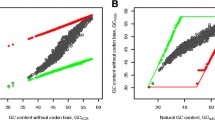Abstract
Recently, we proposed a new model of DNA sequence evolution (Arquès and Michel. 1990b.Bull. math. Biol. 52, 741–772) according to which actual genes on the purine/pyrimidine (R/Y) alphabet (R=purine=adenine or guanine, Y=pyrimidine=cytosine or thymine) are the result of two successive evolutionary genetic processes: (i) a mixing (independent) process of non-random oligonucleotides (words of base length less than 10: YRY(N)6, YRYRYR and YRYYRY are so far identified; N=R or Y) leading to primitive genes (words of several hundreds of base length) and followed by (ii) a random mutation process, i.e. transformations of a base R (respectively Y) into the base Y (respectively R) at random sites in these primitive genes. Following this model the problem investigated here is the study of the variation of the 8 R/Y codon probabilities RRR,..., YYY under random mutations. Two analytical expressions solved here allow analysis of this variation in the classical evolutionary sense (from the past to the present, i.e. after random mutations), but also in the inverted evolutionary sense (from the present to the past, i.e. before random mutations). Different properties are also derived from these formulae. Finally, a few applications of these formulae are presented. They prove the proposition in Arquès and Michel (1990b.Bull. math. Biol. 52, 741–772), Section 3.3.2, with the existence of a miximal mean number of random mutations per base of the order 0.3 in the protein coding genes. They also confirm the mixing process of oligonucleotides by excluding the purine/pyrimidine contiguous and alternating tracts from the formation process of primitive genes.
Similar content being viewed by others
Literature
Arquès, D. G. and C. J. Michel. 1987a. Study of a perturbation in the coding periodicity.Math. Biosci. 86, 1–14.
Arquès, D. G. and C. J. Michel. 1987b. A purine-pyrimidine motif verifying an identical presence in almost all gene taxonomic groups.J. theor. Biol. 128, 457–461.
Arquès, D. G. and C. J. Michel. 1990a. Periodicities in coding and noncoding regions of the genes.J. theor. Biol. 143, 307–318.
Arquès, D. G. and C. J. Michel. 1990b. A model of DNA sequence evolution, Part 1: Statistical features and classification of gene populations, Part 2: Simulation model, Part 3: Return of the model to the reality.Bull. math. Biol. 52, 741–772.
Arquès, D. G. and C. J. Michel. 1992. A simulation of the genetic periodicities modulo 2 and 3 with processes of nucleotide insertions and deletions.J. theor. Biol. 156, 113–127.
Arquès, D. G. and C. J. Michel and K. Orieux. 1992. Analysis of Gene Evolution: the software AGE.Comp. appl. Biosci. 8, 5–14.
Barrell, B. G. and B. F. C. Clark. 1974.Handbook of Nucleic Acid Sequences. Oxford: Joynson-Bruvvers.
Beasty, A. M. and M. J. Behe. 1988. An oligopurine sequence bias occurs in eukaryotic viruses.Nucl. Acids Res. 16, 1517–1528.
Crick, F. H. C., S. Brenner, A. Klug and G. Pieczenik. 1976. A speculation on the origin of protein synthesis.Orig. Life 7, 389–397.
Dickerson, R. E. and H. R. Drew. 1981. Kinematic model for B-DNA.Proc. natn Acad Sci. U.S.A. 78, 7318–7322.
Eigen, M. and P. Schuster. 1978. The hypercycle. A principle of natural self-organization. Part C: The relaistic hypercycle.Naturwissenschaften 65, 341–369.
Ellison, M. J., R. J. Kelleher III, A. H.-J. Wang, J. F. Habener and A. Rich 1985. Sequence-dependent energetics of the B-Z transition in supercoiled DNA containing nonalternating purine-pyrimidine sequences.Proc. natn Acad. Sci. U.S.A.,82, 8320–8324.
Erlich, H. A., D. Gelfand and J. J. Sninsky. 1991. Recent advances in the polymerase chain reaction.Science 252, 1643–1651.
Evans, T. and A. Efstratiadis. 1986. Sequence-dependent S1 nuclease hypersensitivity of a heteronomous DNA duplex.J. biol. Chem. 261, 14771–14780.
Feller, W. 1968.An Introduction to Probability Theory and its Applications. New York: Wiley.
Haldane, J. B. S. 1927. A mathematical theory of natural and artificial selection. Part V. Selection and mutation.Proc. Camb. Phil. Soc.,27, 838–844.
Haldane, J. B. S. 1990.The Causes of Evolution. Princeton, NJ: Princeton University Press.
Hamada, H., M. Seidman, B. H. Howard and C. M. Gorman. 1984. Enhanced gene expression by the poly(dT-dG)·poly(dC-dA) sequence.Mol. cell. Biol. 4, 2622–2630.
Hanvey, J. C., J. Klysik and R. D. Wells. 1988. Influence of DNA sequence on the formation of non-B right-handed helices in oligopurine oligopyrimidine inserts in plasmids.J. biol. Chem. 263, 7386–7396.
Jeffreys, A. J., N. J. Royle, V. Wilson and Z. Wong. 1988. Spontaneous mutation rates to new length alleles at tandem-repetitive hypervariable loci in human DNA.Nature 332, 278–281.
Jukes, T. H. and C. R. Cantor. 1969. Evolution of protein molecules. InMammalian Protein Metabolism. H. N. Munro (Ed.), pp. 21–132 New York: Academic Press.
Keller, E. B. and W. A. Noon. 1984. Intron splicing: a conserved internal signal in the introns of animal pre-mRNAs.Proc. natn. Acad. Sci. U.S.A. 81, 7417–7420.
Kimura, M. 1980. A simple method for estimating evolutionary rates of base substitutions through comparative studies of nucleotides sequences.J. molec. Evol. 16, 111–120.
Kimura, M. 1987.The Neutral Theory of Molecular Evolution. Cambridge: Cambridge University Press.
Konopka, A. K., J. Reiter, M. Jung, D. Zarling and T. M. Jovin. 1985. Concordance of experimentally mapped or predicted Z-DNA sites with positions of selected alternating purine-pyrimidine tracts.Nucl. Acids Res. 13, 1683–1701.
Larsen, A. and H. Weintraub. 1982. An altered DNA conformation detected by S1 nuclease occurs at specific regions in active chick globin chromatin.Cell 29, 609–622.
Mullis, K. B. and F. A. Faloona. 1987. Specific synthesis of DNA in vitro via a polymerase catalysed chain reaction. InMethods in Enzymology. R. Wu (Ed.), Vol. 155. San Diego: Academic Press.
Nei, M. 1987.Molecular Evolutionary Genetics. Washington, DC: Columbia University Press.
Ruskin, B. and M. R. Green. 1985 The role of the 3′ splice site concensus sequence in mammalian pre-mRNA splicing.Nature 317, 732–734.
Shepherd, J. C. W. 1981. Method to determine the reading frame of a protein from the purine/pyrimidine genome sequence and its possible evolutionary justification.Proc. natn Acad. Sci. U.S.A. 78, 1596–1600.
Smith, T. F., M. S. Waterman and J. R. Sadler. 1983. Statistical characterization of nucleic acid sequence functional domains.Nucl. Acids Res. 11, 2205–2220.
Stallings, R. L., A. F. Ford, D. Nelson, D. C. Torney, C. E. Hildebrand and R. K. Moyzis. 1991. Evolution and distribution of (GT)n repetitive sequences in mammalian genomes.Genomics 10, 807–815.
Tautz, D. and M. Renz. 1984. Simple sequences are ubiquitous repetitive components of eukaryotic genomes.Nucl. Acids Res. 17, 6463–6471.
Treco, D. and N. Arnheim. 1986. The evolutionary conserved repetitive sequence d(TG·AC)n promotes reciprocal exchange and generates unusual recombinant tetrads during yeast meiosis.Molec. Cell. Biol. 6, 3934–3947.
Wang, A. H.-J., G. J. Quigley, F. J. Kolpak, J. L. Crawford, J. H. Van Boom, G. Van der Marel and A. Rich. 1979. Molecular structure of a left-handed double helical DNA fragment at atomic resolution.Nature 282, 680–686.
Weber, J. L. 1990. Informativeness of human (dC-dA)n·(dG-dT)n polymorphisms.Genomics,7, 524–530.
Weber, J. L. and P. E. May. 1989. Abundant class of human DNA polymorphisms which can be typed using the polymerase chain reaction.Am. J. Hum. Genet. 44, 388–396.
Wieringa, B., E. Hofer and C. Weissmann 1984. A minimal intron length but no specific internal sequence is required for splicing the large rabbit b-globin intron.Cell 37, 915–925.
Woese, C. R. 1970. Molecular mechanics of translation: a reciprocating ratchet mechanism.Nature 226, 817–820.
Author information
Authors and Affiliations
Rights and permissions
About this article
Cite this article
Arquès, D.G., Michel, C.J. Analytical expression of the purine/pyrimidine codon probability after and before random mutations. Bltn Mathcal Biology 55, 1025–1038 (1993). https://doi.org/10.1007/BF02460698
Received:
Revised:
Issue Date:
DOI: https://doi.org/10.1007/BF02460698




